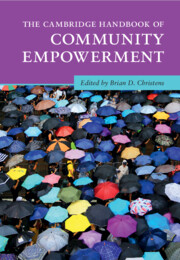Book contents
- The Cambridge Handbook of Community Empowerment
- Cambridge Handbooks in Psychology
- The Cambridge Handbook of Community Empowerment
- Copyright page
- Contents
- Figures
- Tables
- Contributors
- Building Community Power
- Part I Organizing and Activism
- Part II Participatory Governance
- Part III Civil Society and Coalitions
- Part IV Enterprise
- 16 A New Generation of Worker Cooperatives
- 17 Employment Social Enterprises
- Part V Participatory and Community Arts
- Part VI Education and Engaged Research
- Contributor Details
- Index
- References
17 - Employment Social Enterprises
from Part IV - Enterprise
Published online by Cambridge University Press: 18 April 2024
- The Cambridge Handbook of Community Empowerment
- Cambridge Handbooks in Psychology
- The Cambridge Handbook of Community Empowerment
- Copyright page
- Contents
- Figures
- Tables
- Contributors
- Building Community Power
- Part I Organizing and Activism
- Part II Participatory Governance
- Part III Civil Society and Coalitions
- Part IV Enterprise
- 16 A New Generation of Worker Cooperatives
- 17 Employment Social Enterprises
- Part V Participatory and Community Arts
- Part VI Education and Engaged Research
- Contributor Details
- Index
- References
Summary
This chapter examines employment social enterprises (ESEs), organizations that provide employment opportunities to individuals marginalized and excluded in the labor market. Employment social enterprises employ chronically unemployed and underemployed individuals, including formerly incarcerated individuals, immigrants, and opportunity youth. This chapter begins by exploring the history, evolution, and prevalence of ESEs. We then highlight two exemplar ESEs to illustrate the design and demonstrate the impact of these organizations. After examining community power and psychological empowerment within ESEs, we explore different models of ESEs and identify topics for future research.
Keywords
- Type
- Chapter
- Information
- The Cambridge Handbook of Community Empowerment , pp. 438 - 454Publisher: Cambridge University PressPrint publication year: 2024

